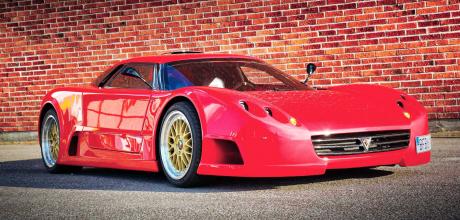Unique home built supercar 344bhp Sensor GTR
Swedish winters are cold, dark and long, so how do you fill the time? Get your brother to help you build yourself a supercar, says Per Ajdén.
A UNIQUE SUPERCAR
Built from the ground up, this home built Sensor GTR is one of a kind
SCRATCH BUILTSENSE OF PERSPECTIVE
UNIQUE HOME BUILT SUPERCAR
‘WE MADE OUR OWN DIHEDRAL SYNCHRO HELIX DOOR HINGES’
It all begun in the year 2000 when my brother Robert read a series of articles about the design and fabrication of a bodyshell for a Swedish car called the Sensor GTR. The designer Ulf Bolumlid created a body out of carbon and glassfibre and with the intent of producing kit cars. He presented the Sensor at some different car shows, the first one being Sweden’s biggest indoor car show held during Easter each year. But the project was never a commercial success and only three bodies were ever produced.
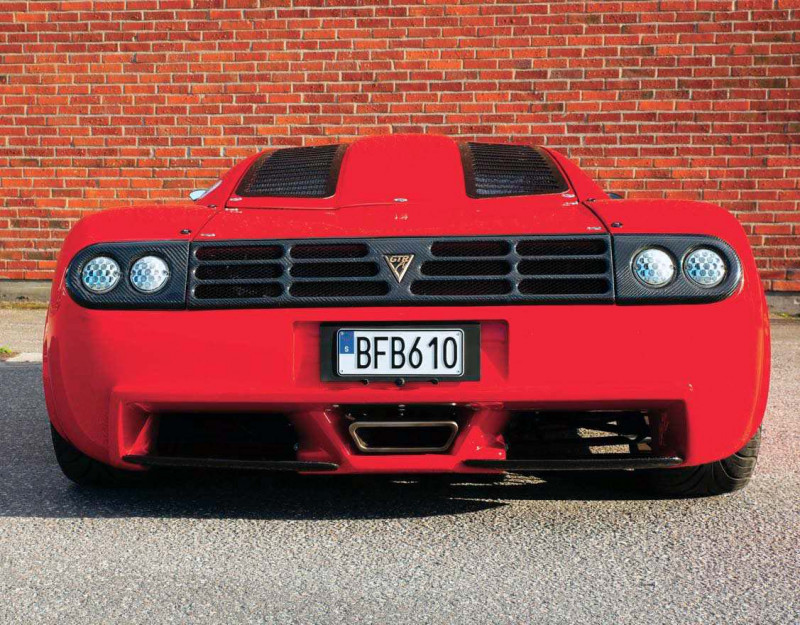
But my brother got interested in building cars in glass and carbon fibre after reading about the dramatic looking Sensor GTR. During the years we’ve built a replica of a Mini Cooper with a Yamaha R1 engine and RWD, a replica of an Ariel Atom with a Volvo T4 engine, and a car inspired by Bentley EXP Speed 8 with an Audi RS6 V8. All of them have spaceframe chassis and glassfibre bodies made by us.
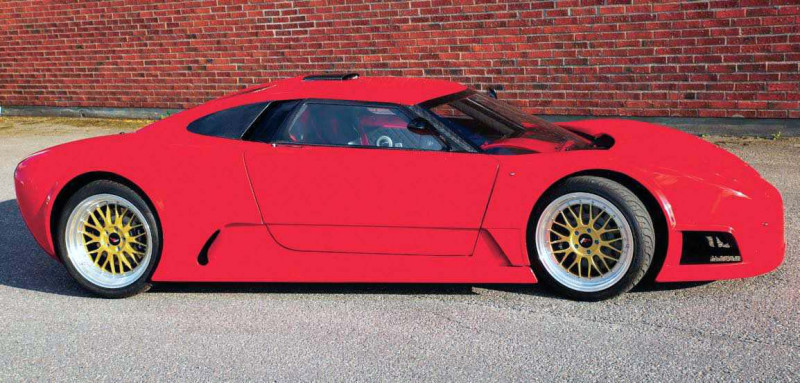
Towards the end of 2016, a couple of years after we had finished the Bentley, I was surfing the internet in search of a half-finished project that I could spend the long Swedish winter working on. The idea was to finish it and sell it to make some money. All of a sudden I came across an advert for a bodyshell of a Sensor GTR about 400km south of where I live. I told Robert and he got exited, remembering the Sensor from 16 years ago.
My brother made a plan to visit a city near where the body was located the weekend after. When he had some free time, he went to have a look at the bodyshell and bought it immediately. A few different people had owned it during the years, but no one since it was made had done anything to it – it was in the same state as when it came out of the moulds. Me and my father went down with a trailer and picked it up.
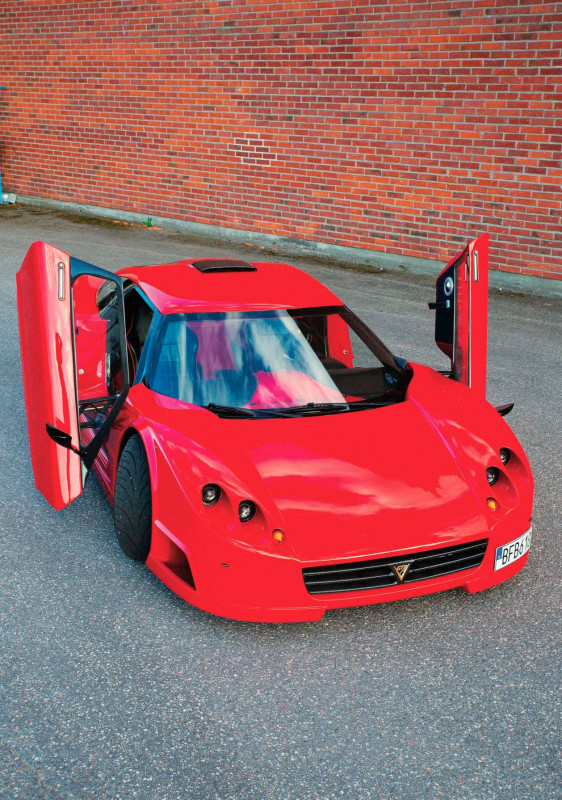
When we got the bodyshell back home we started to design the rest of the car – what we had bought was just the outer shell. We 3D-scanned the body so we could get it into the computer and started to design the spaceframe and everything else that needed to be fabricated in CAD. Being a one-of-a-kind specially designed body almost everything had to be designed and fabricated by us. Much of the suspension geometry and design I reused from what I previously designed for the Ariel Atom replica, because I know it works well after much driving on road and track.
Quite early in the design process we needed to choose what engine and gearbox we were going to use. Our first idea was an Audi V8 and a Audi 01E gearbox but we found it would be impossible to fit them in if we were going to be able to also fit ourselves into the car. The body is very low – now finished the top of the roof sits just 105cm from the ground. This mean we needed to have a quite long driving compartment and have a bit of a lying down driving position. So we moved the rear wall of the driving compartment as far back as possible, and to get extra length we decided to go with a transversely mounted engine.
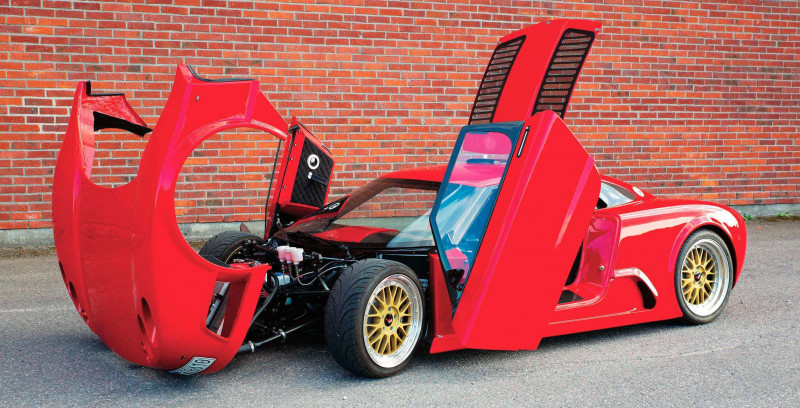
I had some experience of Volvo white engines since I built the Ariel Atom replica with a Volvo T4 and M56 gearbox – and that worked great. We started looking at the T6 engine, but it was a bit too wide to have together with double wishbone suspension, so the choice fell to the T5 which is widely available and has a good reputation here in Sweden.
After the computer design of the chassis was done, we sent all the CAD files to a laser cutter and got 122 individual pipes back perfectly cut – just put them in place and get welding. We started to build the spaceframe on Christmas Eve and one week later we had a rolling chassis ready. It is a very quick work when all the pipes are pre-cut. Everything after that took much longer. I spent almost all spring and summer fabricating plugs, moulds and final versions of all the parts we needed that didn’t come with the bodyshell, such as inner wheel arches, dashboard, frames for the side windows, interior trim, ventilation scoops and many others.
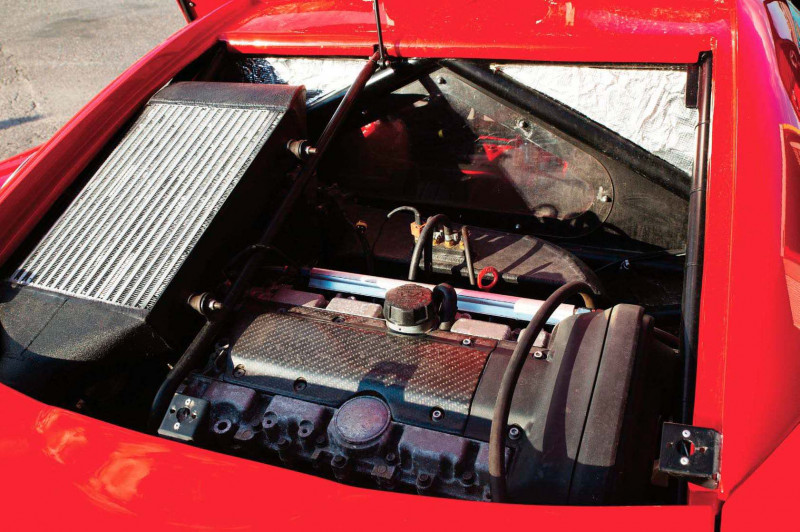
Luckily for us we got in contact with the owner of one of the other three Sensor bodies in existence, and he had some parts from the original prototype that he leant us so we could make moulds – this saved us loads of time. Due to the complex shape of the body we needed to get the doors out from the body to be able to open them, and after some thought I decided that a dihedral synchro-helix door mechanism, as used by Koenigsegg, would be cool. We made the drawings and fabricated the hinges ourselves.
About one year after the start of the project we made the fist test drive just outside the garage, with an unpainted body and chassis, and with a plywood sheet as a floor under our feet, but it worked as it was supposed to.
When all the mechanical work was finally done, we could disassemble it and start with the surface finish, the plan was to get it road legal in the summer of 2018.
During the winter of 2017/2018 the bodyshell was painted in Porsche GT3 red and the chassis powder coated black. We could finally start to put the car back together, and because it’s a spaceframe we could assemble the whole car before putting the bodyshell on. We got all the plumbing and wiring done and installed a Megasquirt 3 Pro ECU. It was even possible to take the car to the dyno and get it mapped before we put the bodyshell on.
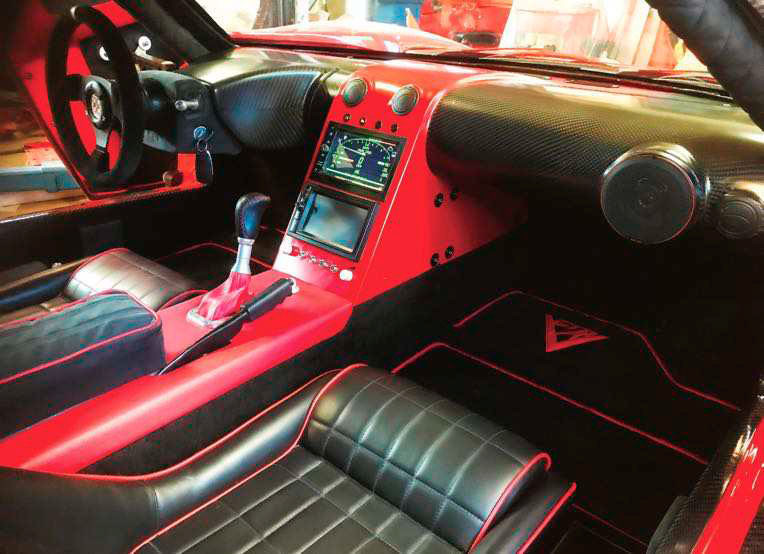
At the end of May we fitted the body to the chassis, and after that it was not much work before we could do the final testing and registration to get it road legal at the end of June. During the summer we drove it to see if anything needed to be fixed during the winter, but everything seemed to work fi ne. However, just because it was now drivable on the road legally does not mean it was finished, far from; we hadn’t even started working on the interior, apart from the dashboard.
We searched for some better seats than the ones we used during the building phase; we found a company in the UK that built copies of Ford GT40 seats on order that we could get custom made for us.
During the winter of 2018/2019 we spent much time on the rest of the interior making everything ourselves – it’s made from both alcantara and vinyl. After the interior was done in early spring 2018, we took the Sensor to the same car show that the prototype had been presented at 18 years earlier. Our car remains the first and only running Sensor GTR ever built. At the show we met the designer of the Sensor, Ulf Bolumlid – he was very happy with the result of our work. He told us that he had started designing it in 1992 and worked on it until 2000, and 26 years after the start of his project we could finally bring it to a conclusion with our finished car.
‘OURS IS THE ONLY SENSOR GTR IN EXISTENCE. IT’S UNIQUE’
TECHNICAL DATA FILE Sensor GTR SPEC
- Engine: 5-cylinder turbocharged Volvo T5
- Max Power: 344bhp @ 6200rpm
- Max Torque: 290lb ft @ 3200rpm
- Transmission: Volvo M56 with Quaife LSD
- Chassis: Space frame designed and built by Per
- Brakes: Discs from Audi A4, Wilwood Dynapro 4-piston calipers
- Wheels: Japan Racing JR23, 7x18in with ET 43 front, 9,5x18in with ET 34 rear
- Tyres: Federal 595 RS-R, 215/40R17 front, 265/36R18 rear
- Suspension: Double wishbone and wheel spindle of own design, bearings and hub from Volvo 850
- Steering rack: Shortened Volvo 850
- Bodyshell: Glassfibre with some parts in carbon fibre, designed by Ulf Bolumlid in the 1990s
- Paint: Porsche GT3-red
- Interior: Dashboard in carbon fibre, seats in genuine leather copy of Ford GT40, the rest in alcantara and vinyl.
- Weight: 1190 kg curb weight
- 0-60mph in under 4.0secs.
Scratch built dash and GT40 seats. Rear end could easily be from an unpronounceable supercar manufacturer. Carbon rear panel. Volvo T5 is well back. Home designed double wishbone suspension. This is defi ntely up there with the most impressive cars we’ve ever featured in PPC. Door hinges are ridiculously clever. Completed home designed spaceframe.
If they’d only managed to make these door hinges that would have been heroic. This winter has been long and cold, but I haven’t managed to build a supercar from scratch yet. built engine combines 1.9-litre capacity with 1.6-litre bottom end. Sensor is only 105cm (41in) high. Cooling rad angled to fit under low snout. Scratch built spaceframe chassis. Engine mapping on the rolling road.
‘ABOUT A YEAR INTO THE PROJECT WE WENT FOR OUR FIRST TEST DRIVE’
‘WE DESIGNED AND BUILT OUR OWN DIHEDRAL SYNCHRO-HELIX DOOR HINGES’


